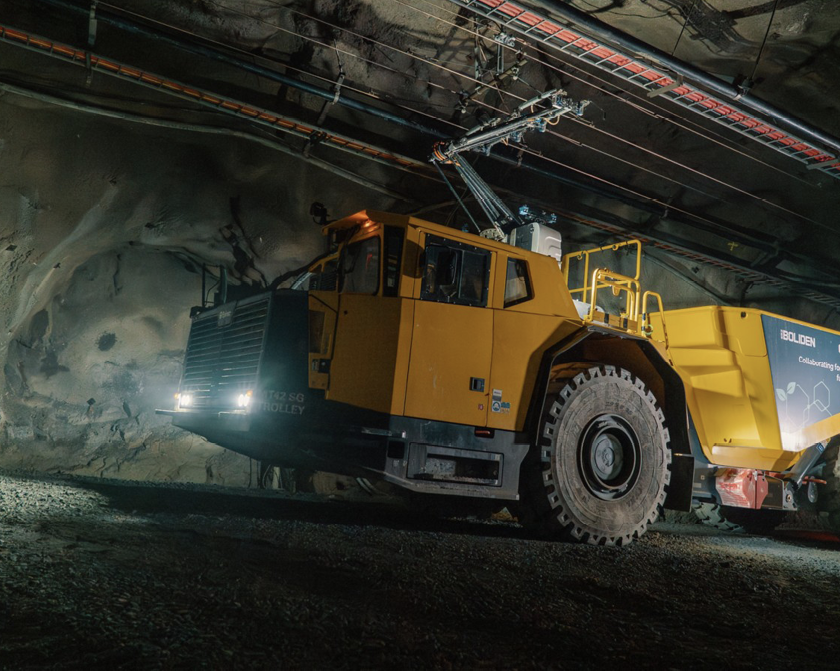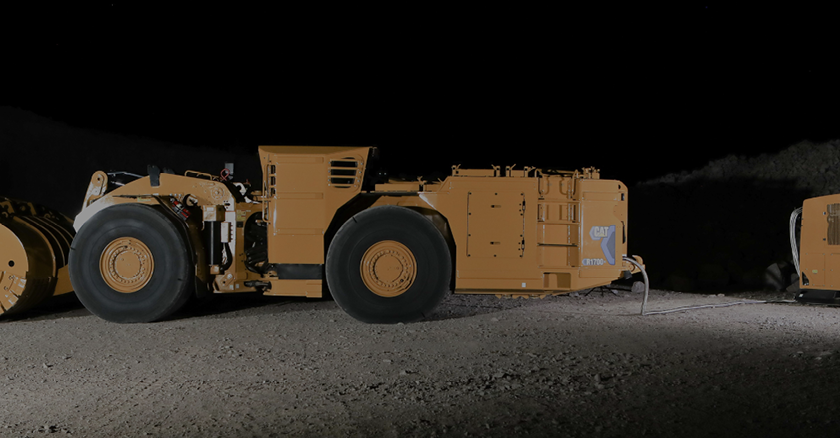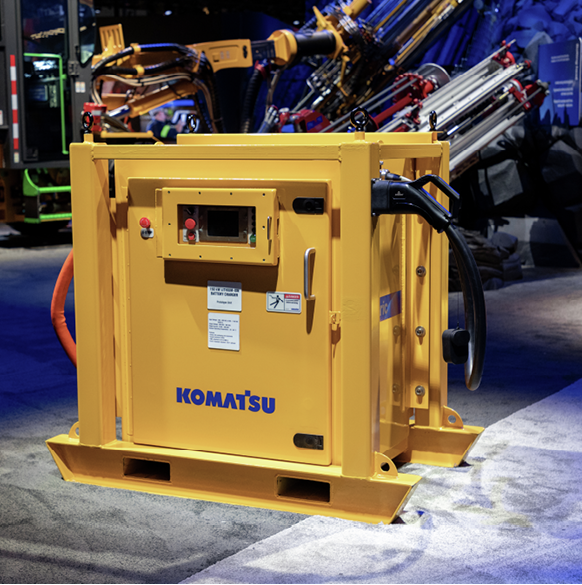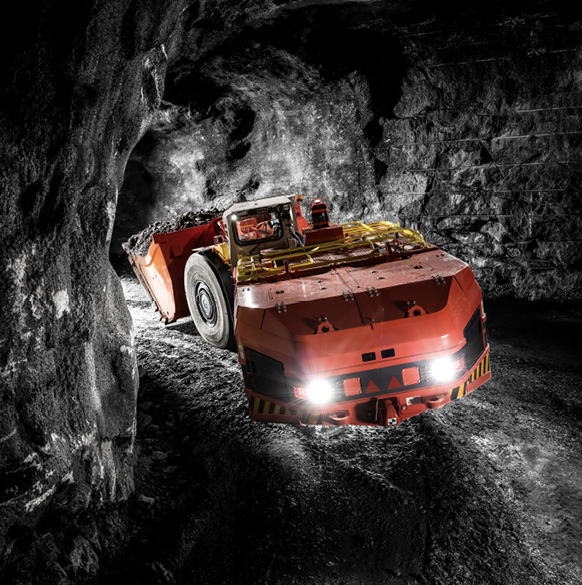As the mining industry moves toward net-zero operations, electrification will play a crucial role in shaping the future of underground mining. North American Mining spoke to several companies whose pioneering electric load and haul solutions are driving the industry toward a cleaner, safer tomorrow.
by Jonathan Rowland

The shift from diesel-powered to battery-electric LHDs promises significant environmental, social and economic benefits, including reduced greenhouse gas emissions, improved air quality and lower operational costs. Yet, as our first contributor ABB noted, underground electrification is not a novel concept; the first commercial solutions date back to the 1980s. However, innovation has recently accelerated as many mining companies look to achieve net-zero commitments.
Several leading companies are spearheading this electrification. We spoke to experts at ABB, Caterpillar, Epiroc, Komatsu, and Sandvik, who are all developing innovative electric LHDs and/or supporting infrastructure to facilitate this transition. These companies are addressing challenges such as battery management, charging infrastructure, and machine availability to ensure the feasibility and efficiency of electric fleets. As these solutions evolve, the mining industry may have reached a tipping point with an all-electric mine now a matter of when, not if.
ABB: real progress toward the all-electric mine
While fleet electrification may seem relatively new and novel to some – a product of the mining industry’s heightened focus on reducing emissions in recent years – ABB began working with the North American mining industry on electric LHDs more than 30 years ago with the Kiruna Electric System. That work was documented in a 1991 CIM Bulletin article (vol. 84:954) entitled “Kiruna Electric: An all-electric ramp haulage for the 1990s and beyond.”
“Since then, we have been on a mission to deliver the all-electric mine, working in collaboration with mining companies, OEMs, and other industry partners,” Sachin Jari, general manager for Mining in North America, told North American Mining magazine. “Last year, we, alongside Boliden and Epiroc, successfully deployed the first fully battery-electric trolley truck system on an 800-meter underground mine test track in Sweden. That milestone brought the mining industry a step closer to realizing the all-electric mine of the future.”
“We’ve seen that, together, we can achieve our shared objectives of sustainable, productive, and safe operations and improved working conditions,” Jari added. “Meanwhile, new findings from the Cosmos electrification study are promising and support that further.”
While it is generally accepted that fleet electrification produces meaningful environmental, social, and governance (ESG) and wellness, health and safety (WHS) benefits, guidance on the practicalities of implementing a BEV fleet in an operating underground mine is limited. The Cosmos study aimed to start filling this gap by determining the technical feasibility, cost, and operational implications of implementing a battery-electric vehicle (BEV) fleet as an alternative to diesel in an existing underground mine – the Cosmos nickel operation in Western Australia.
The Cosmos mine is 100% owned by IGO Ltd., while Barminco (an underground mining contracting arm of Perenti) provides underground mining services. IGO engaged Perenti and ABB to help conduct the study. Cosmos is a promising candidate for full underground mine electrification because it uses a 1,000-m-deep hoisting shaft to move ore and waste to the surface. This limits truck haulage routes to distances compatible with current battery technology.
Completing an electrification study differs from undertaking a feasibility study for a mine with a standard diesel fleet, requiring a re-evaluation of accepted mining practices. In scoping the study, the key questions were:
- Can a BEV mining fleet replace an existing diesel fleet and maintain the required productivities?
- What cost delta is associated with transitioning to and operating an all-electric fleet?
- How long would it take – and what would be required – to transition an operating mine from fully diesel to fully BEV without impacting operations?
As conducted, the study explored:
- Machine availability and fleet selection;
- Mine design considerations including ventilation, battery management and charge bay design;
- Operating philosophy and productivity, including trucking and loading fleet, ancillary equipment and light vehicles;
- Electrical infrastructure and power system analysis;
- Cost modeling; and
- Risk assessment and BEV transition.
Ultimately, the study found that, within the accuracy of a pre-feasibility level of study, converting the Cosmos mining fleet from diesel to battery electric was technically feasible and not cost-prohibitive. Key findings suggest the following:
- Based on OEM-provided assumptions, BEV fleets matching the productivity of the existing Cosmos diesel mobile fleet are available to the market (in this case, in Australia).
- The estimated cost to electrify the Cosmos underground fleet was not prohibitive over the mine’s envisaged life, even based on conservative productivity and cost assumptions.
- The total power consumption of a fully electrified fleet would be less than that of the equivalent diesel operation due to substantial power savings in mine cooling and ventilation.
The ABB team has conducted similar evaluations for mines globally, including North American sites.
“Replacing a diesel underground mining fleet with a battery electric fleet is now technically feasible,” concluded Jari. “Increasingly, fleet electrification will be a key technological enabler for mining companies to achieve their decarbonization goals. The financial impact or benefit will depend on the specific mine characteristic, but it will likely improve as battery capacity improves and economies of scale in BEV manufacturing take effect.”
Editor’s note: The findings for each area explored are detailed in the white paper ‘Making electrified underground mining a reality’ are available at https://campaign-pa.abb.com/perenti-partnership.

Caterpillar expands underground electric haulage options
Caterpillar is growing its line of electric LHDs after successfully demonstrating its first battery-electric prototype underground mining truck at the company’s proving ground in Tasmania, Australia, in 2023. At MINExpo 2024, the Peoria-based company displayed its Cat R1700 XE LDH with 100% battery-electric propulsion.
According to the company, the R1700 XE truck “produces zero exhaust emissions and significantly less heat generation than a reciprocating engine powered model.” Matching the performance of the diesel-powered R1700 and using switch reluctance technology, the “R1700 XE features fast-onboard charging, allowing the batteries to be charged while remaining on the machine. The Cat MEC500 Mobile Equipment Charger fully charges the R1700 XE in less than 30 minutes with a single charger and less than 20 minutes using two units.”
Caterpillar also featured its Cat RC2900 XE diesel-electric LHD at the September 2024 show. Built on the same platform as the company’s most popular underground loader, the R2900G, the electric-diesel model improves breakout force by 35% compared to its diesel counterpart and features a switch-reluctance electric drive system that reduces the number of parts compared to mechanical drive systems. “The R2900 XE meets the underground mining industry’s needs for bigger payloads, faster loading, reduced exhaust emissions, and low total cost of ownership,” the company said.
Epiroc at the forefront of electrification
Epiroc launched its first battery-powered machine in 2016. The company currently offers the 14-tonne ST14 and 18-tonne ST18 BEV Scooptram loaders and the 42-tonne MT42 Minetruck BEV haul truck.
“For the highest demand duty cycles (loaders and trucks), our BEV strategy revolves around swappable battery packs, since this is the fastest way to get energy into the machine,” explained Jon Griffith, PE, product application specialist – Underground. “Modularity is critical to this strategy, allowing the machine fleet to share battery packs within the same model. Even within the battery packs, the individual components are designed to be modular for ease of repair and inventory reduction.”
Real-time monitoring of battery infrastructure is “key to its success,” continued Griffith. “Digitalization and automation will help tremendously in this regard. With continuous real-time monitoring, battery components can be monitored and repaired proactively before a problem arises. Automation will help optimize energy consumption and reduce operator error.”
In addition to its BEV range, Epiroc has continued to develop intermediary products to support the transition to full electrification, such as a trolley-assisted version of the MT42 truck and the new 66-tonne e-drive MT66e haul truck.
“The trolley system integrates with the existing MT42 BEV design, allowing the truck to hook into grid power via a catenary system during the long, uphill ramp drives that typically require the most energy,” explained Griffith. “Once up the ramp, the catenary system retracts, and the haul truck can operate for several hours on battery power when en route to the loading/dumping point.”
Meanwhile, the MT66 e-drive uses a Tier 4 Final (EU Stage V) diesel engine as a generator to power four independent electric drive motors (one located in each wheel hub). “This drive train can improve fuel efficiency by 8-10% while improving ramp speeds by about the same amount,” said Griffith.

Komatsu leaps forward in sustainable underground mining technology
According to Tyler Vien, LHD product manager, Komatsu’s new WX04B battery-electric LHD and its 165 kWh battery represent a “leap forward in sustainable mining technology, delivering efficiency, flexibility and improved safety while minimizing infrastructure requirements. “
A significant challenge in battery-electric mining equipment has been the complexity of battery swaps, often requiring specialized infrastructure or lengthy downtime. Komatsu addresses this with the WX04B’s ground-level battery change system, eliminating the need for cranes, rigging or additional equipment. “It allows you to very quickly and easily change batteries. Just drop the battery to the ground, then drive over and pick up a new one that’s fully charged. In this size class, that’s game-changing,” said Vien. “The seamless swapping system promotes machine uptime with minimal disruption, while the onboard tram battery allows short-distance movement without external power.”
Supporting the WX04B is Komatsu’s brand-agnostic 150 kW charger, which offers a fast-charging solution that requires minimal infrastructure modifications. “With no fixed installation requirements other than an electrical connection, it allows mines to establish charging locations quickly and without significant infrastructure costs,” explained Philip Rosenstern, energy storage product manager.
“The charger is designed to be portable and flexible to match a mine’s evolving needs. This enables operators to reduce downtime and optimize productivity, as a charged battery can be ready in about two hours – less than the runtime of a single charge. Additional findings from product testing have demonstrated a four-hour run time while mucking.”
Beyond power efficiency, the WX04B and its charger contribute to a healthier underground working environment. “Eliminating diesel emissions improves air quality and reduces the need for extensive ventilation infrastructure, offering both environmental and economic benefits,” said Rosenstern. The machine’s battery thermal management system (BTMS) also maintains optimal battery temperature, enhancing performance and extending battery life. This system “ensures reliability in the harshest underground conditions, with batteries built to withstand extreme temperatures, heavy shock, vibrations, and dusty environments.”
According to Vien, the WX04B enhances safety and operational efficiency by incorporating digitalization and automation into its design. Operator-focused safety features include a reinforced boom, optimized geometry, and an optional enclosed cab with environmental controls. Meanwhile, the machine’s interlocks automatically engage the brakes and disable functions when the cab door is open or the seatbelt disengages, further prioritizing worker protection.
Komatsu’s introduction of the WX04B and its 150 kW charger reflects a “strategic shift in underground mining, aligning with the industry’s transition to electrification,” Vien added. These innovations provide a “scalable and adaptable solution for underground operations, reducing emissions without compromising performance.” With initial internal underground testing meeting or exceeding expectations, the company is now looking forward to trialing the WX04B and its 150 kW charger at an operating mine. Commercial availability is expected in mid-2025, marking a “significant milestone in Komatsu’s commitment to sustainability and efficiency in underground mining,” concluded Vien.

Sandvik: toward an electric future through innovation and collaboration
In 2024, Sandvik introduced its newest innovation for the underground loader and truck family: the automation-capable battery-electric Toro LH518iB loader. The machine can transport 18 tonnes of ore with battery power and is a good example of successful global collaboration during product development.
Designing, building, testing, and producing a new generation loader requires expertise and seamless coordination in different areas, Tuulia Rekola, project manager for developing the LH518iB loader, told North American Mining. “During product development, we collaborated globally within the company’s different functions, as well as with several external stakeholders, such as our suppliers and customers.”
For example, Sandvik Load and Haul’s home base is in Finland, but much of the company’s battery know-how is at the Camarillo site in California. According to Rekola, maintaining a seamless connection between these hubs was crucial for the success of this project. In addition, the supplier network is global, and customers are located worldwide. “This adds complexity to the work but is rewarding when all the pieces fit into place,” said Rekola.
“Our product development philosophy is based on our core values, including customer focus,” added Walter Ojala, product line manager for large loaders at Sandvik Load and Haul. “We listen to our customers to understand the big picture; every mine site is different. With the LH518iB loader, we wanted to create the battery technology to make the change from diesel to battery technology as small as possible.”
“The Toro LH518iB loader is a step towards an electric and low-emission future, thanks to the new battery technology,” explained Riku Helle, chief engineer in the LH518iB project. “The operation of our BEV equipment is based on our quick battery swap solution, or AutoSwap as we call it. This allows the loader to continue operating without long battery charging times, during which the machine would be out of use. The battery swap takes on average only about five minutes.”
In addition to its innovative battery solutions, the Toro LH518iB loader features the company’s AutoMine automation technology. Automation even allows simultaneous control of multiple machines from the control room, improving mine safety and operational productivity. The new technology combination, BEV with automation, was tested at Sandvik’s test facilities, including the test mine in Tampere, Finland. Finally, site acceptance tests were conducted on a selected customer mine site.
“I would describe the LH518iB as a fusion of two different technologies,” concluded Ojala. “We have the new battery technology, and then we have the know-how of our mining equipment. The fusion brings those technologies together and brings us this magnificent machine.”
In addition to the BEV loader, Sandvik is fully committed to developing a comprehensive electric offering for underground load and haul operations. For example, the company is developing a large diesel-electric truck using customer feedback and previously obtained results from field tests conducted with a technology demonstrator. Before launching the DE truck for global sales, Sandvik aims to ensure it is thoroughly tested, capable of delivering high tonnage, and meets customer requirements.
Regarding the other large truck, the battery-electric TH665B, testing at a customer site in Australia has been completed, and the truck has been shipped back to the Sandvik Load and Haul home base. Based on the gathered data and learnings, Sandvik will develop a new large BEV truck that is automation-ready and equipped with the latest Sandvik Intelligent Control System version. Additionally, the truck will use the latest Sandvik battery technology upon release.
Once the product development phases are complete and the trucks are thoroughly tested, both will be added to Sandvik’s modular electric product family and global offering.
